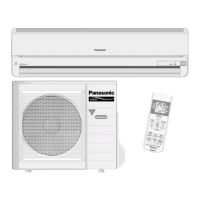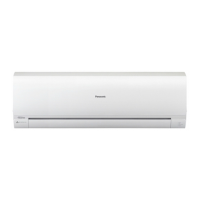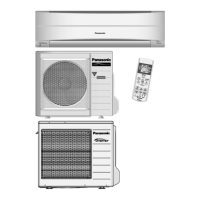Why is there low pressure in heating mode in my Panasonic CS-RE12HKE?
- JJulia SmithAug 7, 2025
Low pressure during heating mode can be caused by an inefficient compressor, insufficient refrigerant, or a clogged strainer or capillary cube.
Why is there low pressure in heating mode in my Panasonic CS-RE12HKE?
Low pressure during heating mode can be caused by an inefficient compressor, insufficient refrigerant, or a clogged strainer or capillary cube.
What causes high gas side pressure in cooling mode in Panasonic CS-RE12HKE?
High gas side pressure during cooling mode can be caused by an inefficient compressor or insufficient refrigerant.
What to do if my Panasonic CS-RE12HKE remote control does not work?
If the remote control for your Panasonic Air Conditioner isn't working, ensure the batteries are correctly inserted or replace weak batteries. The display might be dim, or the transmission signal could be weak.
Why is my Panasonic Air Conditioner heating/cooling operation not working efficiently?
If your Panasonic Air Conditioner's heating or cooling isn't working efficiently, make sure to set the temperature correctly, close all doors and windows, clean or replace the filters, and clear any obstructions at the air inlet and air outlet vents.
What to do if self diagnosis function broke down in Panasonic CS-RE12HKE?
When the Panasonic air conditioner stops due to a malfunction detected by itself, you can restart the operation using the AUTO Switch on the indoor unit.
Why is my Panasonic Air Conditioner noisy during operation?
If your Panasonic Air Conditioner is noisy during operation, check if the unit has been installed at an incline and ensure that the front panel is closed properly.
Precautions for using and handling remote control batteries.
Safety guidelines for the indoor unit installation and operation.
Precautions related to power supply, cords, and earthing.
Safety instructions for the outdoor unit.
Recommended temperature ranges for cooling and heating modes.
Guidelines for battery disposal and recycling of old equipment.
Overview of the unit's buttons, indicators, and remote control display.
Instructions for turning the unit on/off, setting temperature, and selecting modes.
Explains the functionality of HEAT, COOL, and DRY modes.
How to adjust fan speed and vertical airflow direction.
Using POWERFUL/QUIET modes for quick temperature or quiet environment.
Setting and cancelling delay timers for operation.
Safety and methods for washing the unit and its parts.
Recommended cleaning and replacement schedule for air filters.
Procedures for storage and conditions requiring professional service.
Explains normal operating symptoms and their causes.
Steps to check before calling for service to diagnose issues.
How to check and report error codes for troubleshooting.
Instructions for inserting batteries into the remote control.
Step-by-step guide for selecting mode, temperature, and starting operation.
Precautions for using and handling remote control batteries.
Safety guidelines for the indoor unit installation and operation.
Precautions related to power supply, cords, and earthing.
Safety instructions for the outdoor unit.
Recommended temperature ranges for cooling and heating modes.
Guidelines for battery disposal and recycling of old equipment.
Overview of the unit's buttons, indicators, and remote control display.
Instructions for turning the unit on/off, setting temperature, and selecting modes.
Explains the functionality of HEAT, COOL, and DRY modes.
How to adjust fan speed and vertical airflow direction.
Using POWERFUL/QUIET modes for quick temperature or quiet environment.
Setting and cancelling delay timers for operation.
Safety and methods for washing the unit and its parts.
Recommended cleaning and replacement schedule for air filters.
Procedures for storage and conditions requiring professional service.
Explains normal operating symptoms and their causes.
Steps to check before calling for service to diagnose issues.
How to check and report error codes for troubleshooting.
Instructions for inserting batteries into the remote control.
Step-by-step guide for selecting mode, temperature, and starting operation.
| Type | Wall Mounted |
|---|---|
| Cooling Capacity | 3.5 kW |
| Heating Capacity | 4.0 kW |
| Energy Efficiency Ratio (EER) | 3.21 |
| Refrigerant | R410A |
| Power Supply | 220-240 V, 50 Hz |
| Outdoor Unit Dimensions (W x H x D) | 780 x 540 x 289 mm |
| Indoor Unit Weight | 9 kg |












